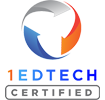Jaclyn A. Thomas, PhD
Come along, step into a new age of learning – one where students have access to knowledge far beyond their borders.
Education, like many of our institutions, is becoming a globalized phenomenon. This concept of globalization refers to how the rise of technology and global trade has created a world of interconnectedness and interdependence. No one is isolated anymore. Bridges between previously separated spaces are built by the worldwide web.
Educational technology, stemming from learning managements systems (LMS) to virtual reality classrooms, is strongly contributing to the globalization of education.
In other words, technology is leading to an interconnected landscape of learning.
From School Houses to the Internet
Many of us, when we think about education, automatically default to the brick-and-mortar public school system. But the public school system hasn’t always been around.
In the formative years of the United States, education was a hodgepodge of schooling arrangements, including church-supported schools, tuition-based schools, town-organized schools, charity schools, and more. In these arrangements, school access was inequal, discriminatory, and inaccessible for much of the population.
It wasn’t until 1830, with the rise of “Common Schools”, that we saw educational institutions that were state-funded, free-of-charge, and in theory, available to all students. That said, it would take many years (following the Civil Rights movement) for these public schools to be truly accessible and equitable.
Along with the changes in the schooling systems, technology associated with learning followed its own trajectory, from the invention of the pencil in 1795, the overhead projector in the 1950s, to the invention of the worldwide web in the 1990s.
Technology has expanded the scope of education, lending to a literal world of possibilities for students, no longer hindered by the constraints of years past.
Current Trends in Ed Tech
Modern technology, like interactive audio instruction, video, and social media, is increasing access to education in underserved and developing regions of the globe. And that technology doesn’t even scratch the surface of what is trending in the ed tech space.
A great example of education technology lending to increasing access to learning materials can be seen in Massive Open Online Courses (MOOCs) – these free online courses are available to anyone, anywhere. And it is cloud computing that has facilitated the large-scale storage and accessibility of educational resources.
Then there are the new digital classrooms and virtual reality, where students can engage in classroom-like settings from the comfort of their living room.
Even more recently, the rise of artificial intelligence (AI) and machine learning has allowed schools and curriculum providers to personalize the learning experience, track student progress, and reduce teacher workloads.
All this technology serves to increase access to quality educational materials and experiences, regardless of geographic, financial, and cultural constraints.
Challenges & Considerations
Still, there are some challenges to be considered.
For example, there is a well-documented digital divide – students have inequal access to the equipment required to use this innovative technology, whether it is computers/laptops or even the internet itself.
As someone who lives in a very rural area, I can tell you, access to the internet is unreliable and incredibly expensive.
Additionally, there are numerous quality control and accreditation concerns in the virtual education market. Not to mention, privacy and data-concern issues in online learning communities.
StrongMind’s Role in Educational Technology
StrongMind doesn’t shy away from the challenge, but rather leans into the opportunities to provide quality education, available at your fingertips. All the while, we are constantly striving to reduce the challenges faced by virtual learning environments.
Not only do we use published research to inform our products and solutions, but we are also constantly engaging in our own research efforts, seeking to expand knowledge around how students, teachers, and parents are using online learning platforms, the effectiveness and enjoyability of our curriculum, and staying up to date on both the educational and technological industry trends.
Technology has allowed education to balloon out beyond our previously established borders, transforming and expanding on what it means as a human to learn. Find out how StrongMind is a driving force in the globalization of education.






